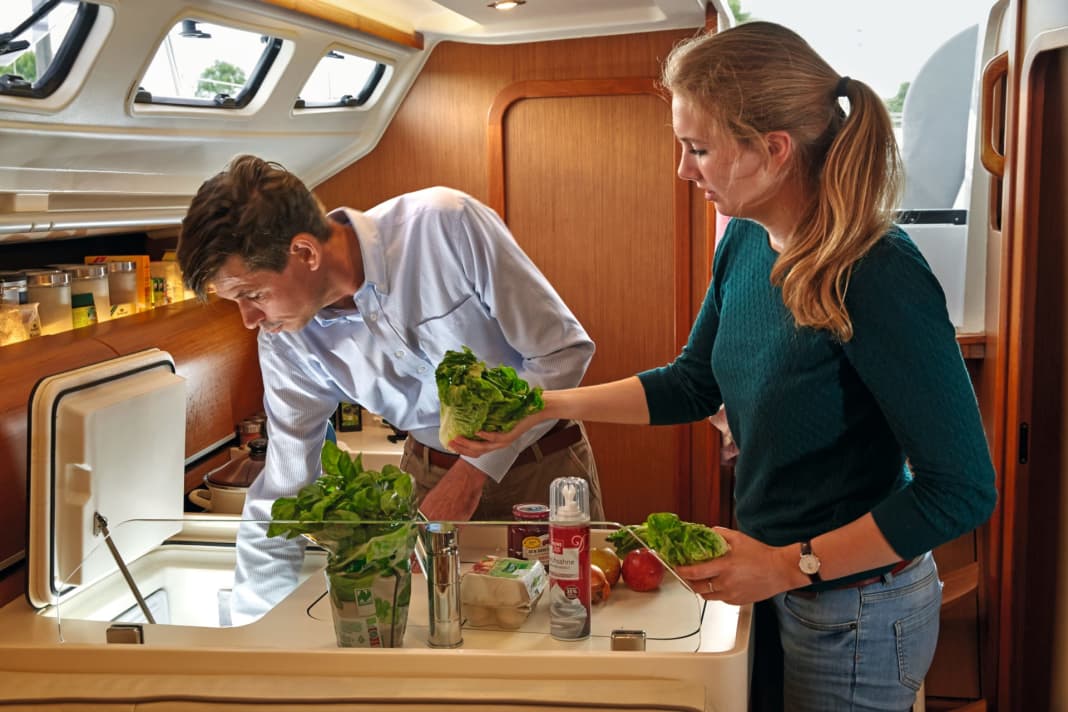




This article is part of a charter special. The contents:
Good cruise preparation starts with the shopping. Strictly speaking, it even starts with writing the shopping list and thinking about what can fit on board - and where. The cruising and long-distance sailor Claudia Kirchberger, who specialises in the subject of provisions and nutrition on board, advises well-considered shopping in her book "Bordversorgung heute" (On-board provisions today) for good reason. To ensure that perishable provisions last longer - which is important not only on long voyages, but also on summer cruises lasting several weeks - they should be bought as fresh and unrefrigerated as possible. Fruit and vegetables must not show any signs of damage.
"Many fresh foods such as eggs, fruit and vegetables can be kept for longer directly from the producer, for example from the farmers' market, than chilled foods from the supermarket," says the Austrian.
Also important for shopping before the trip: it's best to only choose food that you know you like and will really use. It's no use having the best ingredients with you if you're the spaghetti with tomato sauce type and the large variety of provisions is gathering more and more dust in your cupboard or even worse: spoiling. Kirchberger's tip:
Create recipes that are simple and time-saving."
Large outer packaging is best disposed of in the shop. Not only do they take up valuable space on board, but they also suffer particularly if they get damp. It can't hurt to do the bulk shopping for long-life products such as rice, pasta and tinned food a week or two before the start of the cruise. Then you only need to buy fresh food shortly before setting sail. The large stowage is thus somewhat equalised if the provisions come on board in several stages.
It makes sense that everything has a fixed place. That way, you can reach for the drawer with the chocolate bars in the dark and not accidentally end up in the flour. Stowage plans are popular on larger ships with changing crews - perhaps this is also worth considering on your own boat, at least if certain foods are given a new place.
Utensils that help with storage are fruit and vegetable nets. They can be found in stores as net bags or shopping nets. You can also use mesh boxes and resealable plastic containers. During the trip, fresh produce in particular should be checked regularly.
Store fruit correctly
Net or crate - keeping fruit fresh for a long time
- Pineapple Fruit net / Ripe fruit up to one week
- Apples In a net or in a ventilated box, if necessary wrap individually in kitchen / newspaper or baking paper / Several months / Store separately as they release ethylene and allow other fruit / vegetables to ripen more quickly
- Avocados Airy and shaded in a net / Ripe avocados a few days; unripe and unrefrigerated a few weeks / Do not store below six degrees; store separately as they release ethylene
- Bananas Cool, dry and dark, then ripen slowly / Several weeks / Moisten and place in the sun for faster ripening
- Pears Fruit net / Few days
- Cherries, berries Refrigeration / Hardly durable, use up quickly
- Kiwis Fruit net or refrigeration / Few days
- Limes, lemons, oranges In crates, mesh baskets or fruit nets, wrap individually in aluminium foil if necessary / Three to six weeks (approx. two months in aluminium foil) / Do not store together in the refrigerator or with ethylene-secreting varieties
- Mangoes Fruit net / Ripe fruit a few days
- Peaches, nectarines Wrap in kitchen paper to avoid bruising / A few days
- Plums Dark and cool / A few days
- Starfruit In the fruit net / Approximately one week
- Watermelons Cool and dry; cut in the refrigerator / Unripe for a few weeks / Ripe when the underside turns yellow
- Grapes Best refrigerated / Refrigerated one week, unrefrigerated a few days
Store vegetables in a dark and dry place
- Leafy vegetables, salad Wrap in paper and store in a dark place / Maximum one week / Lettuce with stalk facing downwards
- Cauliflower Wrapped in paper or kitchen roll in a vegetable net / Approximately one week
- Broccoli Wrapped in a damp cloth in the refrigerator / Hardly storable, use up quickly
- Fennel Wrap in kitchen paper in a dark place / Fresh tubers up to two weeks
- Ginger Wrapped in paper, dark and airy / Several weeks
- Potatoes, sweet potatoes Cool, dry, dark; wrapped in kitchen paper or in a sandbox / Approximately two months / Unwashed they keep the longest; do not eat sprouted parts (solanine)
- Garlic, onion Airy, dry and separate, e.g. in a net or mesh basket / Several months
- Cabbage Dark, airy and dry in an open crate; wrap in paper if necessary, avoid rolling and bruising / Fresh heads will keep for several months / Once cooled, no longer durable without refrigeration
- Kohlrabi Wrapped in net or paper / Up to three weeks
- Paprika, chilli peppers Individually wrapped in paper / Without refrigeration approx. one week
- Leek, leek In a vegetable net / Fresh and unrefrigerated for several weeks / Dried leeks keep for a very long time
- Tomatoes Airy in open crates / Several weeks / Store separately, give off a lot of ethylene
- Celery Keeps for a long time in a sand box / celery stalks for about a week, corms for months
- Courgette Wrap in paper / Several days / Check regularly

